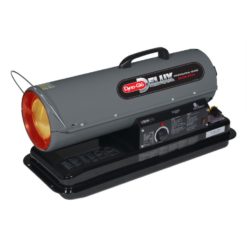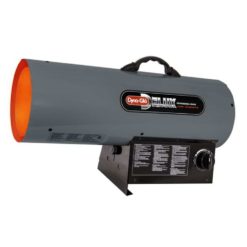Dyna Glo Forced Air Heaters
Want High Volume, High Output Directional Heating? Then take a look at the Dyna Glo Forced Air Heaters range.
These Fan forced air heaters come in Gas and Kerosene models to heat large construction sites.
Dyna-Glo Forced air heaters are designed to heat construction sites fast. They can range from 40,000BTU to 650,000BTU of heat. Naturally, the size of the heater you choose depends mostly on how large the area you intend to heat up is.
Finally, the fuel type the forced air heater uses is another consideration. There are two main fuel types, Kerosene and Gas (LP or Natural).
The main advantage of having a forced air heater is its ability to provide you instant heat, to your worksite. Another key benefit of the forced air heater is its portability. The lower BTU rating heaters or LP Forced air heaters can easily be transported with their easy-grip handles, whereas the larger kerosene models have heavy-duty flat freewheels.
What are Forced Air Heaters?
Forced air heaters as the name suggests foces air out of the heater to achieve High Volume, High Output Directional Heating.
Fan forced air units to provide high volume, directional heat ideal for situations requiring more precise temperatures to be maintained. Select models from the Dyna-Glo Forced Air Heater range come with a thermostat to control the temperature with precision.
Things to consider when purchasing a Forced Air Heater
With either fuel type, with dyna glo, you’ll receive a heater with miminal assembly time and a powerful fuel efficient forced air heater.
Gas or Kerosene
First of all you’ll need to decide between Propane or Kerosene Forced Air heaters. Both types of heaters are very efficient and powerful.
If you’re heating a large construction site larger than 3,500 sq ft, you’ll need to go for the Kerosene Forced Air heaters. These forced air heaters can produce more heat than the gas forced air range.
LP Gas forced air heaters have the advantage of being able to select the tank size. The larger the size of the tank the longer you can keep the heater burning without changing tanks or refueling (up to 70 hours). Of course with both models, it will be easy enough to carry spare LP gas or Kerosene tanks
On the other hand, if you are using it in a fixed location where there is a Natural Gas source then the Natural Gas Forced Air heater will be the choice for you
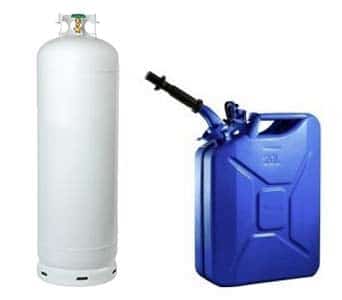
Which to choose
Heating Space
The size of the forced air heater you require will depend on the size of the area you’re planning to heat up. Naturally, if the space is smaller, such as a garage, you’ll tend to go for the smaller models.
Gas Forced Air Heaters
| RMC-FA40DGD | RMC-FA60DGD | RMC-FA125DGD | RMC-FA150DGD | RMC-FA150NGDGD | RMC-FA300DGD | |
|---|---|---|---|---|---|---|
| Maximum BTU | 40,000 | 30,000 – 60,000 | 70,000 – 125,000 | 120,000 – 150,000 | 150,000 | 300,000 |
| Heating Coverage (sq.ft) | 1,000 | 1,350 | 3,100 | 3,500 | 3,500 | 7,000 |
| Fuel | LP Gas | LP Gas | LP Gas | LP Gas | Natural Gas | LP Gas |
Kerosene Forced Air Heaters
| KFA50DGD | KFA80DGD | KFA135DGD | KFA180DGD | KFA220DGD | KFA400DGD | KFA650DGD | |
|---|---|---|---|---|---|---|---|
| Maximum BTU | 50,000 | 80,000 | 95,000 – 135,000 | 140,000 – 180,000 | 180,000 – 220,000 | 400,000 | 650,000 |
| Heating Coverage (sq.ft) | 1,200 | 1,900 | 3,200 | 4,200 | 5,200 | 8,500 | 13,500 |
| Fuel | 14 hours | 9 hours | 14 hours | 10 or 12 hours | 8 or 10 hours | 10 hours | 10 hours |
| Fuel Capacity (gallons) | 5 | 5 | 10 | 13 | 13 | 29 | 50 |
Thermostat Control
Select models of the Dyna-Glo Forced Air Heater range have a thermostat control. Having a thermostatic control can save cost on fuel whilst keeping the temperature at the optimum range.
Safety features:
Safety is the number one consideration when purchasing any type of heater. All of Dyna Glo forced air units are CSA certified and they provide the very best efficiencies in the safest manner possible. With the Dyna-Glo Heater Range, there are range of safety features included :
Temperature Limit Control :
These heaters are equipped with a Temperature Limit Control designed to turn off the heater should the internal temperature rise to an unsafe level. If this device activates and turns your heater off it may require service
| MODELS | Internal Shut-Off Temp. Plus/Minus 10 Degrees | Reset Temperature Plus/Minus 10 Degrees |
| KFA50DGD | 176˚F/80˚C | 122˚F/50˚C |
| KFA80DGD | 158˚F/70˚C | 104˚F/40˚C |
| KFA135DGD | 158˚F/70˚C | 104˚F/40˚C |
| KFA180DGD | 230˚F/110˚C | 194˚F/90˚C |
| KFA220DGD | 194˚F/90˚C | 140˚F/60˚C |
Electrical System Protection:
Dyna Glo Kerosene Forced air heater electrical system is protected by a fuse mounted to the PCB assembly that protects it and other electrical components from damage. If your heater fails to operate check this fuse first and replace as needed.
Flame-Out Sensor :
Utilizes a photocell to monitor the flame in the burn chamber during normal operation. It will cause the heater to shut-off should the burner flame extinguish
Weight
LP Gas Forced air heaters will be lighter to carry as the fuel is a separate source. Kerosene on the other hand can get quite heavy, especially with a full fuel tank. The larger models have flat-free wheels to make transportation easier.
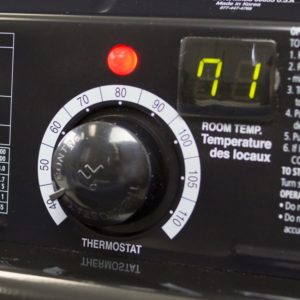
Thermostat Control
Want precision temperature control? Get a model with thermostat controls
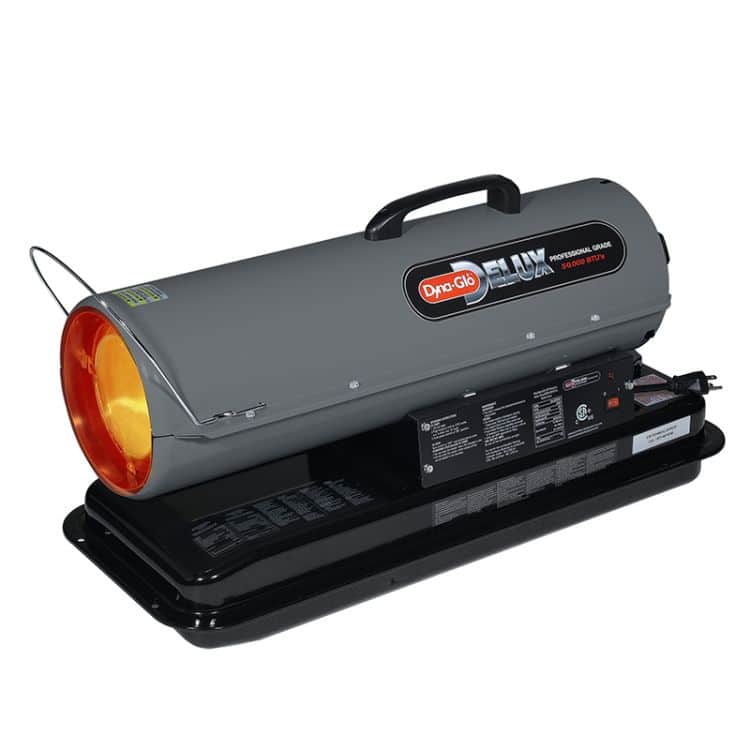
Dyna-Glo KFA50DGD 50,000 BTU Kerosene Forced Air Heater-runtime indicator
Perfect for smaller areas such as smaller garages

Dyna-Glo Delux KFA650DGD 650,000 BTU Kerosene Forced Air Heater
The largest in the Kerosene Forced Air Heater range, suited for large construction or industrial warehouses. Heatsareas up to 13,500 sq ft.
Frequently Asked Questions
Is this safe to run in a garage with minimal ventilation?
The manufacturer GHP Group recommends that you need to provide a fresh air opening of at least three square feet (2,800 sq. cm) for each 100,000 BTU/Hr. rating. Provide extra fresh air if more heaters are being used.
Example : A KFA220DGD (220,000BTU) heater requires one of the following:
- a two-car garage door raised six inches (15.24 cm)
- a single-car garage door raised nine inches (22.86 cm)
- Two, thirty-inch (76.20 cm) windows raised fifteen inches (38.1 cm
Will a kerosene forced air heater run on #2 diesel , #1 diesel?
For optimal performance of this heater, it is strongly suggested that 1-K kerosene be used. 1-K kerosene has been refined to virtually eliminate contaminants, such as sulfur. This can cause a rotten egg odor during the operation of the heater. When kerosene fuel is not available you can use the following fuel types:
- #1 Diesel
- #2 diesel
- JET A fuel
- JP-8 fuel
Be advised that these fuels do not burn as clean as 1-K kerosene, and care should be taken to provide more fresh air ventilation to accommodate any added contaminants that may be added to the heated space see less.
#2 diesel/fuel oil heavier than 1-K kerosene in extreme cold temperatures without nontoxic anti-icer additives will not ignite properly
Is there anything else I need to buy to get a forced air heater started?
These Dyna Glo Forced air heaters come ready to use, some models require assembly of the handles but all you need to do is connect to power and add fuel.
Do you need to use the fan for it to operate? Do you need power for it to operate?
Yes, you need to plug this unit in to operate it and the fan is part of the operation of the unit.
My Kerosene forced air heater is blowing smoke out when using diesel. How can I fix this?
The blowing of smoke when using diesel, may be related to a pressure issue. To adjust the pressure of a Dyna-Glo Kerosene Forced Air heater unit you can use a flat head screwdriver to the screw below the high low switch and turn one turn clockwise to up the pressure.
How do I prepare my Kerosene forced air heater for the summer?
To ensure your Dyna Glo Kerosene Forced Air heater starts first go next season here are simple steps to get it ready.
- Remove fuel drain bolt from rear bottom side of fuel tank using 3/4” socket or adjustable wrench and drain.
- Using a small amount of kerosene, swirl and rinse the inside of the tank.
NEVER mix water with the kerosene as it will cause rust inside the tank. Pour the kerosene out making sure that you remove it all.
It’s IMPORTANT to NOT store kerosene over summer months for use during next heating season. Using old fuel could damage the heater.
- Reinstall Fuel Drain Bolt to Fuel tank and tighten firmly using 3/4” socket or adjustable wrench.
IMPORTANT : Before reinstalling the fuel drain bolt, make sure the seal is on the bolt. If the seal is not used the bolt cannot be installed correctly and the fuel tank will leak. - Store heater in a dry well ventilated area. Make sure the storage place is free of dust and corrosive fumes.
- Store the heater in the original box with the original packing material
Is breathing kerosene fumes bad for you?
IIt’s best to avoid breathing in kerosene large quantities of kerosene vapour or drinking kerosene-based liquids as it may cause dizziness, headache and vomiting. Repeated skin exposure may result in dermatitis (eczema). A short, one-off exposure to kerosene is unlikely to result in any long-term effects.
Can you get carbon monoxide poisoning from a kerosene heater?
kerosene heaters can produce large amounts of soot and carbon monoxide when running out of oxygen. Failure to follow safety precautions could result in asphyxiation or carbon monoxide poisoning. Which is why it is very important to ensure adequate ventilation is supplied when using a kerosene heater.

